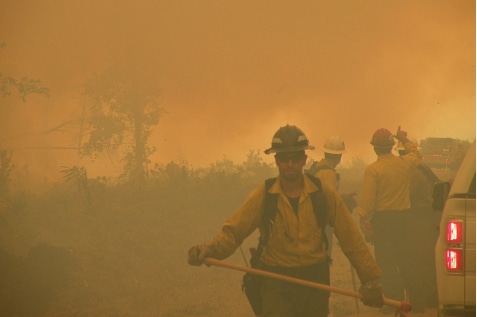It has been said that no business can operate in isolation, and this is equally true when it comes to preparing for all possible emergency scenarios. At first glance, it might seem that external influences can only be minor, but in fact, the impact can be quite serious. Developing an emergency plan to deal with the impact from external influences is, therefore, vital.
Between the possibility of a fire breaking out in a neighbouring building to the effect that extreme weather conditions can have on a building and its occupants, there is no escaping the fact that the safety of your own workers may be compromised.
There are two principal external influences on emergency plans for any business: firstly, events on a neighbouring premises; and secondly, extreme weather conditions.
What Happens Next Door
Most businesses have neighbouring enterprises, and it is imperative to consider how an emergency there can impact on your own business.
You might wonder what could happen? Well, for a start, a fire there might spread, or a chemical accident might place your own employees at risk through vapour released into the air or spills flowing towards your premises.
Of course, there are two sides to the coin, with an emergency on your premises also having the potential of a serious impact on your neighbours’ businesses too.
- Impacting on Neighbours
- Consider steps to protect neighbours during an emergency
- Ensure a line of communication to provide warning
- Emergency plans may need to be coordinated with neighbours
- Preventative measures may need their consent
- A shared safe area may need to be accommodated (their car park perhaps)
- Impacted on by Neighbours
- Consider the distance between buildings, and what the possible threats are
- Where a road is near, consider the impact traffic accidents might have
- Prepare evacuation plans to deal with neighbouring emergencies (fire, chemical accident etc)
- Consider alternative safe areas, depending on source
- Consider impact from adjacent buildings too
Extreme Weather Conditions
Emergencies are not always a result of accidents in the workplace. They might also be a result of extreme weather conditions or natural disasters. From flash floods to bush fires and cyclones to tsunamis, there is a need to react quickly in the face of the worst that nature can throw at us.
In such cases, we are all reliant on warnings issued by the weather bureau, the police and other emergency services, so there is a great need to maintain a communication line with these bodies and services.
This will ensure the earliest possible warning, giving everyone the maximum time available to put an emergency plan into action. But there are several aspects that need to be considered.
- Consider the weather-related risks that exist around your premises
- Choose suitable safe areas in the case of each
- Consider protective structures/barriers to hamper fires or floods
- Identify safe exit routes off the business premises in case of extreme weather warnings
- Suitable indoor shelter may be necessary for sudden storms or cyclones
- Ensure reliable communication lines are available and in order
- Consult the relevant local authorities to tie the plan in with official evacuation procedures
- Consider procedures for off-site workers, like delivery personnel
In all emergency situations, it is imperative that designated staff are fully trained in evacuation procedures. By ensuring individual staff are fully aware of what to do, reaction times are quicker, evacuations are more swiftly accomplished and the chances of a tragedy occurring are drastically reduced.
Information is key in all matters relating to an emergency, regardless of whether it occurs on the premises or is caused by outside influences. So, keeping staff fully briefed on emergency plans and any revised versions will save lives. Posters and easy-to-follow guides are essential parts of the plan too.
For further reading on Emergency Plans and how to go about drawing them up, check out the official Safe Work Australia PDF file: www.safeworkaustralia.gov.au/AboutSafeWorkAustralia/WhatWeDo/Publications/Documents/657/Emergency_plans_fact_sheet.pdf
Many external influences such as fire, chemical attacks have a harmful effect on the eyes. If not treated immediately, these can cause irreparable and possibly, even complete damage, to eyesight. However, immediate washing off of the debris and hazardous liquids in the eye can save vision. It is important to install eyewash stations at workplaces. Get yours today and save the gift of eyesight!
Further Reading:
- ‘Get Fire Danger and Severe Weather Warning Information’, Australian Broadcasting Corporation – www.abc.net.au/local/stories/2012/01/06/3403436.htm
View Previous Posts in this Series:
- Part 1 – Workplace Emergency Plans: What You Need to Know
- Part 2 – Types of Workplace Emergency Plans: Points to Consider
- Part 3 – How to Formulate an Effective Evacuation Plan
Image Courtesy: U.S. Fish and Wildlife Service Northeeast


LEAVE A REPLY
Your email address will not be published. Required fields are marked *
You must be logged in to post a comment.